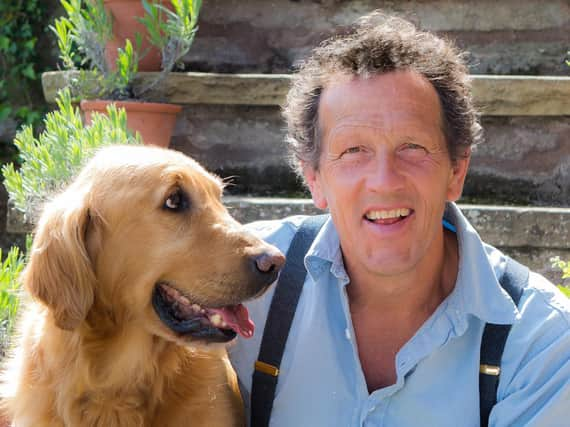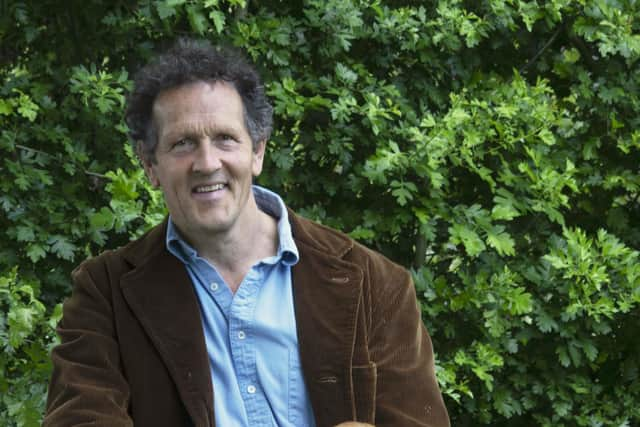Monty Don on appreciating wildlife during lockdown, how gardeners can do their bit for the planet and losing his dog, Nigel


“I’ve hardly left my garden since early March,” he says, speaking before the latest lockdown was introduced. “Lockdown hugely affected filming, but it hasn’t stopped it. For about a month we filmed it ourselves and since then, the garden has been laid out with miles of cable and equipped with robot cameras. I mic myself up, so everything you see of me is just me alone in the garden speaking to robots.”
He’s also managed to find the time to finish two books – My Garden World, about his connection with wildlife, and American Gardens, written with Derry Moore.
Advertisement
Hide AdAdvertisement
Hide AdMy Garden World features many of his detailed observations about wildlife. “I’ve always been fascinated by birds, wildflowers and wild animals, but particularly birds,” he says. “Throughout my adult life in the garden, the fellow travellers – the frogs, the beetles, the ladybirds, even the aphids and the worms, as well as the more spectacular birds like sparrowhawks – have been a rich part of my gardening experience.


“That also proved to be very true in lockdown. One of the things we’ve noticed on Gardeners’ World is that more and more people are showing an interest in the wildlife in their garden, not necessarily rare wildlife. It’s just as fascinating seeing a robin as it is seeing a peregrine falcon, in its own way.”
His favourites, he admits, are birds of prey. “In my lifetime, almost all birds of prey have increased hugely. There was a disastrous decline in the Fifties and Sixties, but they’ve recovered very well, with the exception of the kestrel. But I’m now seeing birds of prey that I dreamed of seeing when I was in my 20s. A few days ago a peregrine falcon circled around my garden. That was unimaginable 40 years ago.”
Of course, most of us may not be so lucky to see these majestic species, but we can take pleasure in the more common wildlife, and Don is now urging gardeners to do their bit to attract all creatures great and small to their gardens.
Advertisement
Hide AdAdvertisement
Hide Ad“Instead of trying to attract one type of animal, the secret is to have a rich and varied garden with lots of cover, plenty of shrubs, hedges and trees, seeds and pollen, so you have insects, birds that eat insects, and birds that eat birds – and you have a chain of life. One of the points of the book is that even the most humble back garden can do that.”
Don remains optimistic about the future of wildlife in our gardens, having seen the organic movement grow in the last 50 years, and a trend towards more naturalistic planting. “We have an environmental crisis that is under way – it’s too late to stop it – but the garden is a way that ordinary people can connect with that crisis and do something about it.
“It’s fine for politicians and campaigners to have big talk about saving the planet – let’s plant trees, let’s all go vegan – but it’s pie in the sky. Most people can’t relate to that. But you can relate to having a little bit of long grass in your garden, or a little pond. If everybody does something small, you end up with big action.”
Don says there are several ways to attract more wildlife to your garden, like providing water. “It can literally be a little half barrel but having some kind of pond will attract a range of wildlife, from frogs and dragonflies, but also insects which will in turn attract birds and bats.”
Advertisement
Hide AdAdvertisement
Hide AdLong grass provides fantastic cover. “Not only can you grow wildflowers in it, which is great for pollinating insects, but also it’s good cover for insects and small mammals like voles and shrews, frogs and all kinds of smaller life.”
He says a bit of untidiness can be beneficial, too. “Have a few heaps of leaves around, or gather up some sticks and put them in a corner, which will provide cover. If your garden is big enough to grow hedges or shrubs or trees, so much the better.”
But even the smallest of spaces, like a balcony, can attract an array of pollinators. “Grow plants for pollinators in pots, types which bees and other insects will come to. Even with a window box you can be part of that.”
Don also wants to talk about his dog Nigel, who he said goodbye to back in the spring. “I miss him all the time,” says the 65-year-old. “If Nigel was here now, he’d probably be bringing me a ball and rolling it on the desk and saying, ‘Come on, get off the phone’. I have other dogs – my golden retriever, Nellie; Patti, a little Yorkshire terrier; and two dachshunds, who never appear on telly. It’s a houseful of dogs.”
Advertisement
Hide AdAdvertisement
Hide AdDon still cannot quite believe how famous Nigel became. “He was such a part of the garden and so loved around the world. I remember being stopped in the street in Tokyo, and checking in for a flight in the mid-west in America, and the guy checking me in said, ‘Hey, why didn’t you bring your dog?’”
Nigel died completely unexpectedly the day after Don finished the book. “The day he died we went for a nice walk and he enjoyed it. He ate his meals perfectly well, I put him to bed and he was really happy. He got ill around midnight and was dead by midday the next day,” he recalls.
The dog suffered a major seizure. “It was a shock, it was very sudden. We were filming the day it happened and I had to go on filming. That was quite tricky.” But he is grateful that his four-legged friend did not have a prolonged illness. “He had a lovely last day and was quite happy. He’d lived a long life and he didn’t have that decline.”
Of course, he still misses him terribly. “We didn’t tell anyone for a week after he died because we just wanted to process it privately. He might have been a star around the world, but he was just part of our family.”
Advertisement
Hide AdAdvertisement
Hide AdNigel is now buried in the garden at Longmeadow. “I feel very strongly that when you get a dog, you know that at some point in about 10 years’ time either you or they are going to die. And depending how old you are, it’s probably going to be them,” Don reflects. “You can be upset by it but you shouldn’t be shocked by it. You need to prepare yourself for things. I’ve put down about five dogs now. It doesn’t get any easier, but it’s something you have to do.”
Nigel was buried with 50 yellow tennis balls, his bowl full of an extra helping of food, biscuits and a bunch of mayflowers, with a stone set above him surrounded by foxgloves, anemones and primroses. As Don says: “Life will flow on all around him.”
My Garden World, by Monty Don, and American Gardens, by Monty Don and Derry Moore, are both out now.
Support The Yorkshire Post and become a subscriber today. Your subscription will help us to continue to bring quality news to the people of Yorkshire. In return, you'll see fewer ads on site, get free access to our app and receive exclusive members-only offers. Click here to subscribe
Comment Guidelines
National World encourages reader discussion on our stories. User feedback, insights and back-and-forth exchanges add a rich layer of context to reporting. Please review our Community Guidelines before commenting.